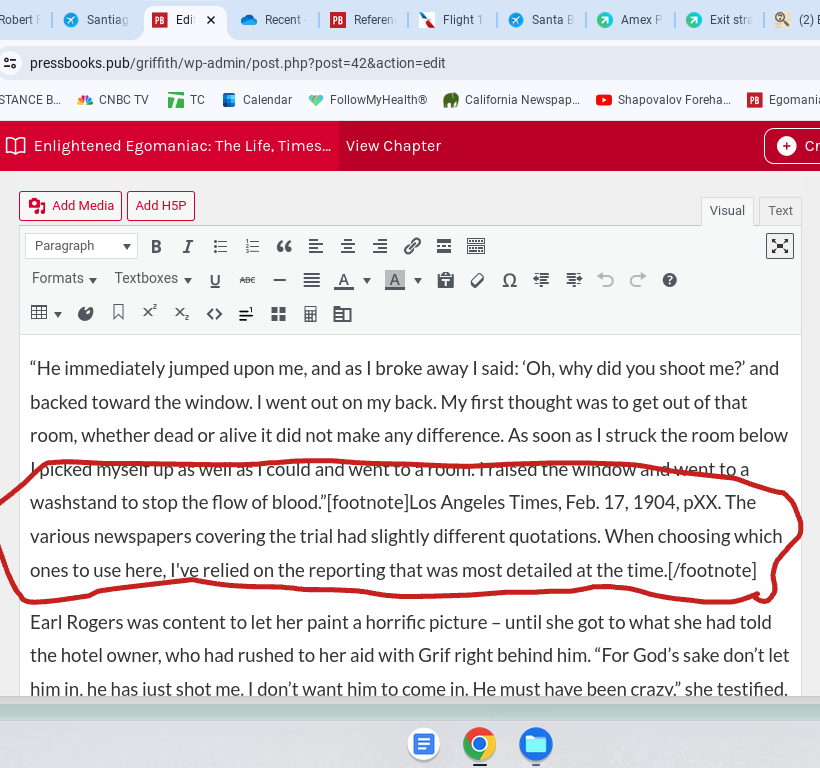Progress Report: Copying Content to Pressbooks & More
OK, the guilt got to me — as in I feel bad that I’ve been silent in the six weeks since I wrapped up sharing draft chapters of “Enlightened Egomaniac”! That and the fact that we have some new readers (welcome and feel free to ask/opine!) has energized/guilted me into updating folks on where this experiment stands.
To start with, I’ve been slowwwwlyyyy copying draft chapters to Pressbooks, which is where I’ll publish the ebook and then make it available for free!
I’ve gone back/forth on whether to charge — if I don’t, I worry readers and even libraries will feel it’s not a serious work; if I do, I won’t reach as many readers. But since this is all one big experiment in how non-fiction is published (ie correcting/updating content when needed, not on a traditional print schedule) I’ve settled on free and hope I can still “sell” it as a valuable improvement to a historical record — that of Griffith Jenkins Griffith and the huge legacy he left Los Angeles.
You can check out my progress at Pressbooks.pub/Griffith. I’m still incorporating feedback from the draft process, and three big hurdles loom ahead:
Footnotes. The Pressbooks footnotes tool is annoying in that when editing a chapter the entire footnote gets inserted exactly where the footnote appears in the copy. Readers see the footnotes at the end of each chapter, so that’s good, but the editor has to navigate footnote copy plastered into areas throughout a given chapter.
Here’s a short example:
I’m getting used to it, but it also is making me limit footnotes so I don’t have to wade through so many when editing chapters. Deciding when to footnote is an art in itself — I don’t want to slow down readers with lots of footnotes, but I also don’t want readers to wonder where the heck a given piece of info came from.
Bibliography. I’ve got 125 books listed at worldcat.org, click here to check them out! But I’m dreading having to migrate that over to pressbooks. There’s a tool called zotero that I’ll experiment with, but if anyone has experience and can help please leave a comment below!
Index. Pressbooks doesn’t have an index tool, at least not yet. I’ll be asking them about any plans to do so. If it’s not forthcoming I’ll look around for a third party tool that would let me, chapter by chapter, create one and then import it to Pressbooks. If anyone has experience with that please let me know.
Future Topic?
Collaborating with readers is a key part of this experiment — getting chapter feedback, but also chatting about ideas for a future research topic. I have had two possibilities percolating in my mind. Let me know what you think of these, or if you want to nominate something/someone else!
Aline Barnsdall: I’d be surprised if anyone outside East Hollywood has heard of her, but she was quite the pioneer in her prime (1920s). Having inherited oil money, she bought hilltop property with the idea of creating an artists’ utopia and had Frank Lloyd Wright build her home there as a centerpiece. She fired Wright and the utopia never happened, so no happy ending. But her story could be a great way to peer into how women were fighting for their rights, and artists were struggling for their space in society. Her Wikipedia entry is pretty limited, and the only Barnsdall biography was back in 1993, before the Internet allowed for deeper dives into history!
SoCal’s Early Aviation Daredevils: You might recall reading that Van Griffith, Grif and Tina’s son, was one of those pioneers, even providing an air field at Griffith Park for several years! The most famous aviators that created the aviation industry in Southern California were Glenn L. Curtiss (the Wright brothers’ main competitor) and Don Douglas. There’s plenty of daring-do and events that changed the course of local history so it could be fun to focus on those guys, and a few gals. I need to reach out to the premiere SoCal aviation library to see if anyone has captured that early history by focusing on a few short biographies. If not, USC has an aviation history project that could be a gold mine of information, check it out here.
Recommended (Similar) Reading
Finally, I just wanted to share two books that I found entertaining and, more importantly, educated me as to parts of history I had not known:
Beverly Hills Spy. Even if the title is misleading (yes the ‘spy’ did live there, but 95% of the story unfolds elsewhere!) it’s a sad story of a heroic British aviator, Frederick Rutland, who ends up helping Japan prepare for Pearl Harbor. It also bothered me that author Ronald Drabkin only used footnotes to add some detail, but never to cite sources. Overall, though, it was an easy, entertaining read.
Fever in the Heartland. Timothy Egan is one of my favorite authors, and here he uses previously hidden (in a garage, no less) papers to shed light on how the Ku Klux Klan had a second coming in the 1920s. Great notes and bibliography show how much effort he put into this.
So that’s it for the update, I hope to jump those hurdles and publish the ebook in the fall — and then off to a new research topic!



Very interesting reading Miguel! I enjoyed especially your own story and look forward to a new beginning soon!